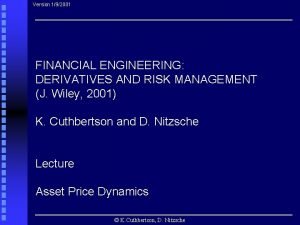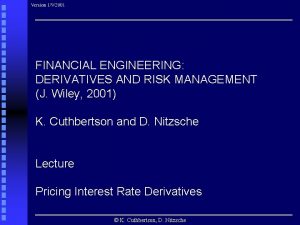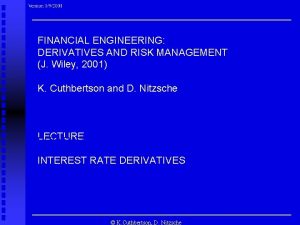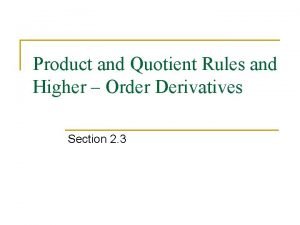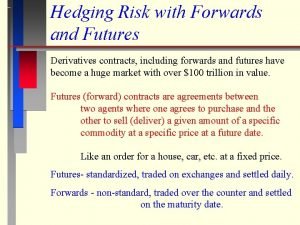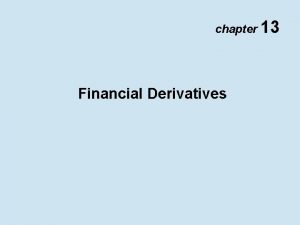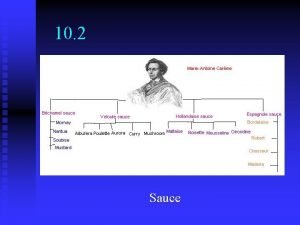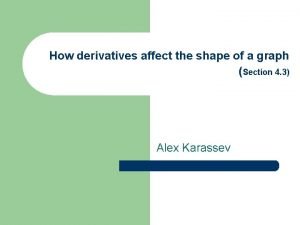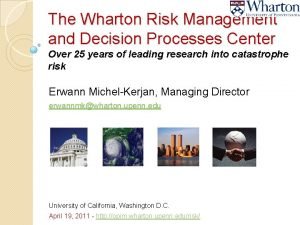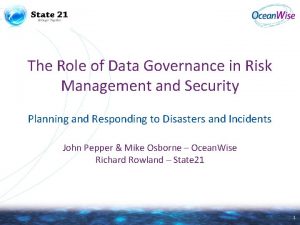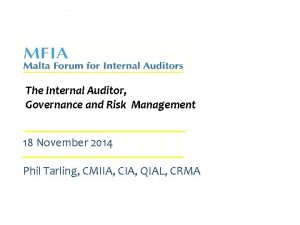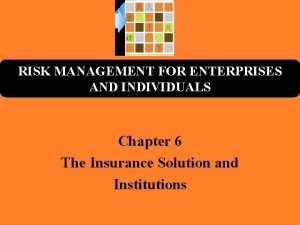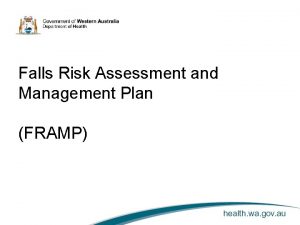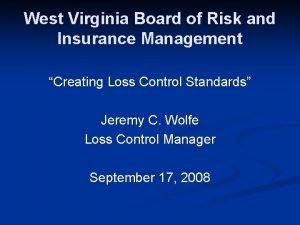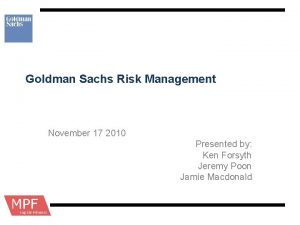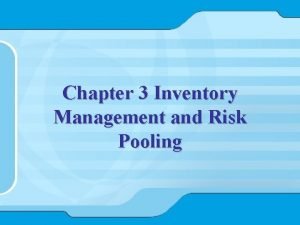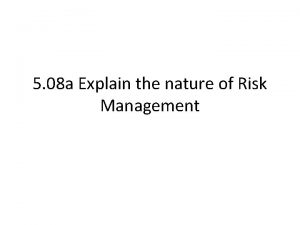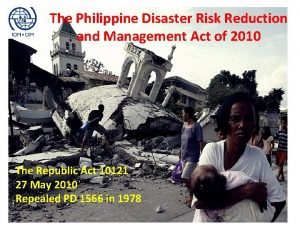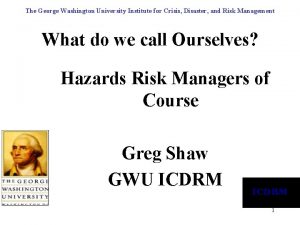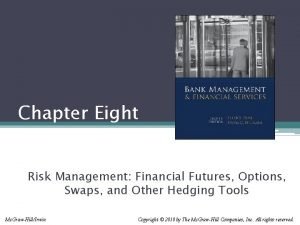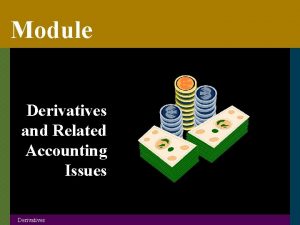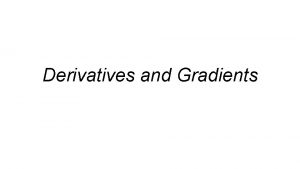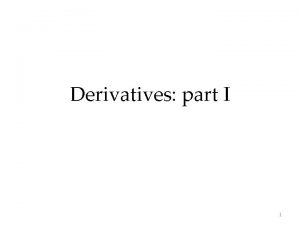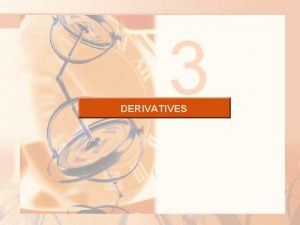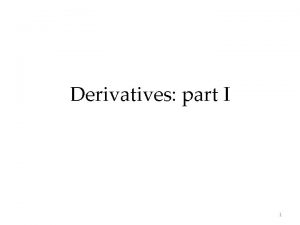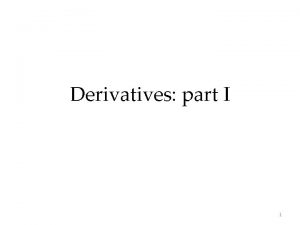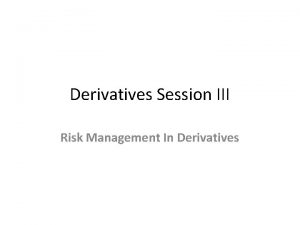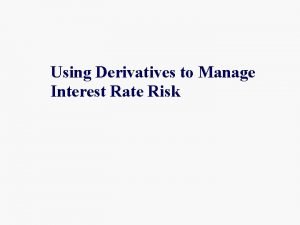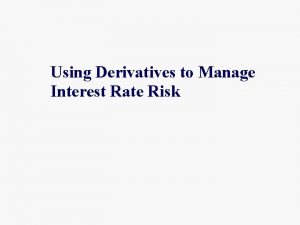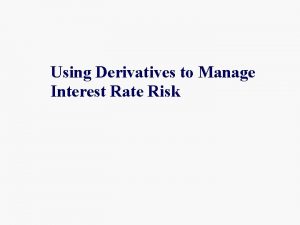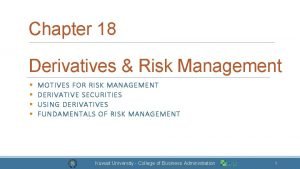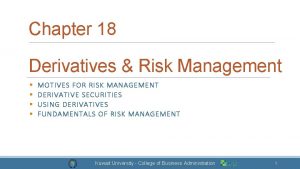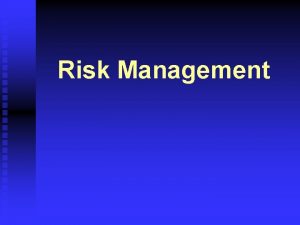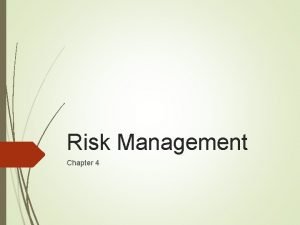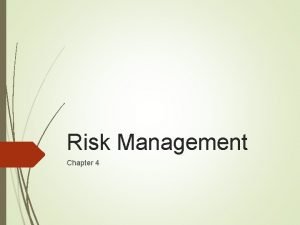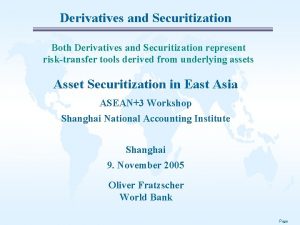RISK MANAGEMENT AND DERIVATIVES MCCOM 4203 E 04

























































- Slides: 57

RISK MANAGEMENT AND DERIVATIVES MCCOM 4203 E 04

Unit 1 CONTENTS Conceptual framework of Risk: • Concept of uncertainty; • Operating risk and financial risk; • Systematic. Vs unsystematic riks; • Components of Risks-market Risk: • Foreign exchange Risk, Interest rate Risk, Liquidity Risk and purchasing power Risk.

Introduction Risk involves exposure to some types of danger and possibility of loss or injury, degree or probability of such loss. In general, risks can apply to our physical health or job security. In finance and investing, risk often refers to the chance an outcome or investment's actual gains will differ from an expected outcome or return. Risk includes the possibility of losing some or all of an original investment. In risk, the probable outcomes of all the possible events are listed. Majority of the investors have one of the following motives or a combination of them. i. Regular income either in the form of dividend or interest. ii. Capital gain or capital appreciation. iii. Hedge against inflation, a positive real rate of return. iv. Safety of funds and regularity of payments of interest and principle. v. Liquidity and marketability in the sense that investor can convert his investment into cash or liquidity and back into investment when cash is not needed.

*** In security analysis involves an examination of expected return and accomanying risks. The first three motives of income, capital appreciation , and a positive hedge against inflation refer to expected return. The last two motives like sefety, liquidity &marketability lead to the risks involved in the investments. Investors generally desire to have the maximum return possible, as they like returns, but they dislike the risk, and the extent of risk aversion varies from investor to investor. But the return depend on the extent of risk that the investor takes. The return composes of riskless return (t-Bill, bank deposit) plus a risk premium depending on the risk taken by the investor.

*** All investments carry with some degree of risk. In the financial word, individuals, professtional money managers, financial institutions, and many other encounter and must deal with risk. Investors can either accept or try to mitigate the risk in investment decision making. If they choose inaction and engage in inadequate risk management, they are likely to experience severe consequences. If investors take appropriate actions given their investment objectives and risk tolerances they may lessen potential for investment losses. Manging risk has become increasingly difficult due to the mutiple aspects of risks. The risk management offers considerable advantages to investors, managers, regulators, and institutions. Before developing a risk management strategy, each group must recognize how to identify sources of risk and understand how to mitigate them. Risk is commonly classified into various group including market, credit, operational , and liquidity.

Concept of risks All investment are risky. The degree of risk varies on the basis of features of assets, investment instruments, mode of investment or issuer of the security etc. , even the so called riskless assets like bank deposits carry cost and time in realisation of proceeds or conversion into cash. Risk is used in many ways depending on the field , the common definition of risk is uncertainty and undesirable outcome i. e actual return differ from expected return. The risk has two important charateristics are: 1. Uncertainty i. e an event may or may not happen. 2. Loss i. e an event has unwanted consequences or losses. "Risk = probability x loss" alternatively, Risk= probability of loss X the amount of loss It also defines risk as, “the possibility of loss, injury, or other adverse or unwelcome circumstance; a chance or situation involving such a possibility”. Risk is an uncertain event or condition that, if it occurs, has an effect on at least one [project] objective.

Concept of risks and uncertainty The risks are due to uncertainty of returns, regularity of returns, safety of funds, marketability or lack of it, etc. Risk and uncertainty go together. Risks suggest that the decision maker knows that there is some possible consequences of an investment decision, but uncertainty involves a situation, where the outcomes is not known to the decision maker. But basically , whether the outcome is known or not , the investment involves both risk and uncertainty. The risk is used to all elements of variability of return, unceraity of the outcomes. etc. Some risks can be controlled by the investors and some by the issuers of securities by planning. Unceratinty can not so controlled and they are to be borne compulsorily by the investor. Examples of uncertainty-based risks include: damage by fire, flood or other natural disasters. unexpected financial loss due to an economic downturn, or bankruptcy of other businesses that owe our money, loss of important suppliers or customers, decrease in market share because new competitors or products enter the market.

Differntiate between risks and uncertainty Basis Risk Uncertainty 1. meaning probability of winning and It implies a situation where lossing something worthy the future events are not is known as risk. known 2. ascertainmnet can be measured can not be measured 3. outcome chances of outcome are known unknown 4. control Controlled &predictable uncontrolable & unpredictable 5. minimization possible difficult 6. probabilities assigned not assigned

Elements/Components of Risk The risk consists of two components: I. Systematic Risk, II. Unsystematic risk. I. Systematic risk: The systematic risks is caused by factors external to the particular company and uncontrollable by the company. The systematic risk affect the market as a whole. The systematic risks affect entire market. This indicates that the entire market is moving in a particular direction either downward i. e bear hug or upward ie. bull market. for example: The economic condition, political situations and the sociological changes affect the secutity market. The recession in the economy affect the profit prospect of the industry and the stock market all over the world. The 1998 recession experienced by developed and developing countries has affected the stock market. The south East asian crisis has affected the stock market world wide. The factors beyond the control of the corporate and the investor. They can not be entirely avoided by the investor. It drives home the point that the systemetic risk is unaviodable. The systematic risk is further sub-divided into a. Market risk, b. Interest rate risk, c. Purchasing power risk.

a. Market risk is the possibility of an investor experiencing losses due to factors that affect the overall performance of the financial markets in which he or she is involved. Market risk, also called "systematic risk, " cannot be eliminated through diversification, though it can be hedged against in other ways. Some known causes of market risk include economic recessions, shifts in interest rates and political unrest. Jack Clark kas defined as that portion of total variability of return caused by the alternating forces of bull and bear market. During bull and bear market , securities' prices rise or fall along with the stock market indices. Market risk is the risk of loss due to the factors that affect an entire market or asset class.

Types/Sources of market risks

Sources of market risks There are four primary sources of risk that affect the overall market: 1. Interest rate risk: The risk associated with stock prices 2. Equity price risk: The risk of unpredictable interest rate changes. 3. Foreign exchange risk : Exchange rates can change rapidly as they are affected by a wide range of political and economic conditions. 4. Commodity risk: It caused by the fluctuation in the prices of commodities. These commodities may be grains, metals, gas, electricity etc. Sources of market risk include recessions, political turmoil, changes in interest rates, natural disasters and terrorist attacks. This can be contrasted with unsystematic risk, which is unique to a specific company or industry.

*** • Some of the event that have created the bull and bear market in the Indian stock market. • For example: In between august 1997 to Jan 1998, Congress withdraws support to Govt, Fall of U. F Govt, BJP led coalition forms Govt, U. S imposes sanctions and decline in rupee value etc. indictes some of the event that have created the bull and bear run in the Indian stock market. • Another example of Pokhran blast on may 13, 1998, and the fall on BSE sensex by 162 points. impending sanctions, damped sentiments and FIIs selling of stocks set a bear phase.

*** The forces that affect the stock market are tangible and intangible events. The tangible events are real events such as earquake, war, flood, political uncertainty and fall in the value of currency. Intangible events are related to marker psychology. This was affected by the real event but reactions to the tangible events become over reaction and they push the market in a particular direction. is market Bull e. g policies gave happiness/ability to float in the market. The market psychology was positive, small investors entered the market and prices of stock soared up. In 1996, the political turmoil and recession in the economy resulted in the fall of share prices and the small investors lost faith in the market. There was a rush to sell the share and the stocks that were floated in the primary market were not received well.

Market risk protection /Minimizing risk exposure • The investor has to study the price behviour of the stock or market. • Investor cn gauge the risk factor and make wise decision according to his risk tolence. • Investor should be prepared to hold the stock or securities for a period of time to reap the benefits of the rising trends in the market. he should be carful in the timing of the purchase and sale of securities. He should purchase at the lower level and should exit at a higher level.

b. Interest Rate Risk • Companies borrow or lend in local currency or in a foreign currency, at specified rates of interest. Interest is the reward to the investor, subsequent to the borrowing or lending the interest rate structure in the market may change. This may have the effect of altering the future cash flows of the company or its futute value. This is known as the interest rate risk. This may be divided into two elements: a. Income risk and b. Capital risk • A. Income risk: There are two types of interest rate -fixed interest rate and floating interest rates. Fixed rate remains the same throughout the duration of the contract. An example of fixed interest rate is Government bond for 5 years with coupon rate of 10%. A floating rate is fixed with reference to a benchmark rate and change periodically with changes in the benchmark rate. • Illustratively, the rate may be fixed for a long-term with reference to LIBOR as the benchmark rate. The exact terms may be that interest be charged at 2% over LIBOR to be adjusted every 6 months. The rate of interest in this case is charging with changes in LIBOR. The effect of floating rate is to keep the interest rate in tune with current trends. • A long- term investor can achieve the effect of floating rate by investing for a short -term and rolling over the investment on due dates at the prevailing rates of interest.

*** • For borrowing at floating rate runs, the borrower at floating rate runs the risk that at futue revisions, the rate of interest may be higher and thus the interest expenditure turns out to be higher. A lender at floating rate runs the risk of reduction in his income if the future interest rate is lower than the current rate. • For borrowing and lending at fixed interest, the risk is measured with respect to the opportunity cost. For instance, if the borrower agrees for an interest rate of 12% and subsequently, the interest rate for a similar loan become 10%, for the future period, he pays interest at 2% higher than the rate paid by new borrowers. A person who has invested or lent at fixed rate loses opportunity income if the interest rate moves up. • This potential for losing the realised or opportunity income in the case of investment, and the potential for having to pay higher interest or losing the opportunity of paying lower interest constitutes the income risk.

*** B. Capital Risk: It refers to the reduction in the value of a fixed income yielding financial assets may suffer due to change in interest rate. Suppose that a bank holds 12% Government bond maturing after 5 years, bought at the rate of Rs 98. If the government issues a new bond carrying interest at 14%, the market value of of 12% bond will fall. This can be expalined as follows: Currently, the 12% Government Bond is yielding Rs 12. 24 i. e 12/98 X 100= Rs. 12. 24. The 14% bond issued at par return a yield of 14%. Therefore, the market price of the existing 12% Govt Bond will be readjusted to yield the current level of 14%. As a result, the market price may fall to Rs 86 : i. e 12/X X 100 = 14 X = 12 X 100/14=Rs. 85. 7 0 r Rs 86 It may be noted that capital riks arises when long term assets are held for a short time. Banks buy Government securities in the secondary market when they have surplus funds or to fulfil the liquidity requirement. These securities are disposed of when the need arises. Banks are therefore exposed to a great extent to capital risk due to interest changes.

*** • Interest rate risk is the probability of a decline in the value of an asset resulting from unexpected fluctuations in interest rates. It is mostly associated with fixed -income assets (e. g. bonds). The variation in the single period rates of return caused by the fluctuation in the market interest rate. The fluctuation in the interest rates are caused by the changes in the Government monetary policy. • The bonds issued by the Governmenet and quasi-government are considered to be risk free. If higher interest rates are offered, investor would like to switch his investments from private sector bonds to public sector bonds. The Govenment tide over the deficit in the budget floats a new loan/bonds of a higher rate of interest, there would be a definite shift in the funds from low yielding bonds to high yielding bonds and from stocks to bonds.

*** • The rise or fall in the interest rate affects the cost of borrowing. Most of the stock traders trade in the stock market with borrowed funds. The increase the cost of borrowing /margin affects the profitabilty of the traders. Interest rate not only affect the secutity traders but also the corporate bodies who carry their business with borrowed funds. • The cost of borrowing would increase and heavy outflow of profit would take place in the form of interest to the capital borrowed. This would lead to a reduction in earning per share(EPS) and a consequent fall in the price of share. • For example, an investor buys a five-year, $500 bond with a 3% coupon rate. Then, interest rates rise to 4%. The investor will have trouble for selling the bond when newer bond offerings with more attractive rates enter the market. The lower demand also triggers lower prices on the secondary market. The market value of the bond may drop below its original purchase price. In other words, when the interest rate increases, the price of a bond decreases. The reverse is also true. A bond yielding a 5% return holds more value if interest rates decrease below this level since the bond holder receives a favorable fixed rate of return relative to the market.

*** • Interest rate risk is the danger that the value of a bond or other fixed-income investment will suffer as the result of a change in interest rates. Investors can reduce interest rate risk by buying bonds that mature at different dates. They also may allay the risk by hedging fixed-income investments with interest rate swaps and other instruments. • Interest rate risk is the risk associated with interest rate fluctuations in assets. Interest rates and bond prices are inversely related. Certain products and options, such as forward and futures contracts, help investors hedge interest rate risks. Forward contracts are agreements in which a party can purchase or sell assets at a certain price on a specific future date. • Shorter-term bonds have a lower interest rate risk, since there is a shorter period of time within which changes in interest rates can adversely impact the bonds. Conversely, there is a higher interest rate risk associated with longerterm bonds, since there may be many years within which an adverse interest rate fluctuation can occur.

*** • Since longer-term bonds expected rate of return is typically higher than the rate on shorter-term bonds, which is known as the maturity risk premium. • Interest rate risk can be mitigated, either by diversifying one's investments across a broad mix of security types, or by hedging. In the latter case, an investor can enter into an interest rate swap agreement with a third party, thereby offloading the risk rate fluctuations into the other party. e. g Interest rate swaps: A agree to pay B interest in fixed rate and B agree to pay A in floating rates i. e benchmark rate (LIBOR+%).

Asset and liability structure • For financial institutions like banks, the structure of their assets and liabilities(A&L) assumes greater importance due to interest rate risks. When both A&L are interest bearing, there additional dimensions to the interest rate risk. These are known as basic risk and gap exposure. • The basic risk arises when the interest on A&L are rekoned on different bases. For instance, suppose a bank lend six months LIBOR plus 1% which is funded by the bank accepting six months term deposits. The bank expects to roll over both the loan and the deposit at the end of six months. It is possible that the variation in the LIBOR may not match with that for term deposits. • Gap exposure arises when the A&L mature for different periods. For instance, the bank may have committed for two years lending but funding may be in the form of deposit for six months. At the time of renewal of deposits, the interest rate may vary which will not be accompanied by similar change in interest rate on advances.

MANAGING INTEREST RATE RISK Interest rate risk is managed with such derivative instruments as Swaps, FRAs , and Interest rate options. The derivatives that are based on interest rate fall under two categories: 1. Some of the derivatives aim at reducing cost of borrowing: i. e Swaps. 2. Some instruments are meant to ensure that cost of borrowing does not exceed the pre-determined level or the income on investment does not go below the expected level. e. g Forward rate agreement(FRAs) and interest rates options. Discuss in detail in the following Unit ***

C. Purchasing power/inflation risk • Inflation risk, also called purchasing power risk, is the chance that the cash flows from an investment won't be worth as much in the future because of changes in purchasing power due to inflation. Inflation or rise in prices lead to rise in costs of production, lower margins, wages rise and profit squeezing etc. • The return expected by investors will change due to change in real value of returns. Purchasing power involves the connection between a dollar and the amount or quality of the goods or services a consumer can purchase. As inflation constantly changes the value of a dollar, the purchasing power of the dollar goes up or down depending on whether inflation rises or falls. • The costs of goods and services are among the most important determinants of purchasing power. When the price level rises, purchasing power decreases, and when the price level falls, purchasing power increases, if all other factors are held equal.

*** • Variation in the return are caused also by the loss of purchasing power of currency. Purchasing Power risk is the probable loss in the purchasing power of the returns to be received. The rise in price penalises the return to the investor, and every potential rise in price is a risk to the investor. • The inflation may be demenad -pull or cost -push inflation. Demand pull inflation, the demand for goods and services are in excess of their supply. The demand for products pushes the price upward. The equilibrium between demand supply is attained at a higher price level. Cost-push inflation, inflation or the rise in price is caused by the increase in the cost of material, labour and equipment makes cost of prodcution high and ends in high price level.

*** • The annual rate of inflation in terms of Consumer Price Index(CPI) and Wholesale Price Index(WPI). A CPI measures changes in the price level of a weighted average market basket of consumer goods and services purchased by households. CPI measures the average change in prices over time that consumers pay for a basket of goods and services. • CPI is widely used as an economic indicator. It is the most widely used measure of inflation and, by proxy, of the effectiveness of the government’s economic policy. It is usually calculated and reported by the Bureau of Economic Analysis and Statistics of a country on a monthly and annual basis. • WPI is also used to measure inflation. A wholesale price index is an index that measures and tracks the changes in the price of goods in the stages before the retail level – that is, goods that are sold in bulk and traded between entities or businesses instead of consumers.

*** • Investors' income has increased but the real rate of return has declined. Thus changes that occur in the purchasing power also cause variation in the expected return and actual return. • To tide over the purchasing power risk, the investor should try to ensure that nominal rate of return is geater than the inflation rate prevailing in the economy. • Purchasing power risk is inherent in all investment and can not be controlled. Thus, Purchasing Power Risk affect returns from bonds, debentures and stocks.

How does Inflation risk Works? • For example: $10, 000 in bonds with a 10% coupon might generate enough interest payments for a retiree to live on, but with an annual 3% inflation rate, every $1, 000 produced by the portfolio will only be worth $970 next year and about $940 the year after that. • The rising inflation means that the interest payments have less and less purchasing power. And the principal, when it is repaid after several years, will buy substantially less than it did when the investor first purchased the bonds. • Some securities attempt to address this risk by adjusting their cash flows for inflation to prevent changes in purchasing power. Treasury Inflation Protected Securities (TIPS) are perhaps the most popular of these securities. They adjust their coupon and principal payments for changes in the consumer price index, thereby giving the investor a guaranteed real return.

*** • Some securities inadvertently provide some load-risk protection. For example, variable-rate securities provide some protection because their cash flows to the holder (interest payments, dividends, etc. ) are based on indices such as the prime rate that are directly or indirectly affected by inflation rates. Convertible bonds also offer some protection because they sometimes trade like bonds and sometimes trade like stocks. Their correlation with stock prices, which are affected by changes in inflation, means convertible bonds provide a little inflation protection. • Inflation risk is still a common worry for income of investors. Inflation causes money to lose value, and any investment that involves cash flows over time is exposed to this inflation risk. The investor earns a lower return that he or she originally expected. • It is important to note that inflation risk isn't the risk that there will be inflation, it is the risk that inflation will be higher than expected.

II. UNSYATEMATIC RISKS Unsystematic risk is unique peculiar to a firm or an industry. This is from managerial inefficiency, technological change in the production process, availability of raw material, changes in the consumer preference, financial leverage, and labour problems. It is known and controllable factors, internal and preditable. This may differ from industry to industry, and company to company. They have to be analysed separately for each industry and the firm. All the factors form the unsystematic risks and contribute a portion in the total variability of the return. Unsystematic risks can be classified into: 1. Business risk, 2. Financial risk , and 3. Insolvancy or default risk

1. Business Risk • The term business risks refers to the possibility of a commercial business making inadequate profits (or even losses) due to uncertainties - for example: changes in tastes, changing preferences of consumers, strikes, increased competition, changes in government policy, obsolescence etc. Examples of uncertainty-based risks include: • damage by fire, flood or other natural disasters. • unexpected financial loss due to an economic downturn, or bankruptcy of other businesses that owe money. • loss of important suppliers or customers. • decrease in market share because new competitors or products enter the market.

*** • It is the possibilities a company will have lower than anticipated profits or experience a loss rather than taking a profit. It is influenced by numerous factors, including sales volume, per-unit price, input costs, competition, and the overall economic climate and government regulations. • Variation that occurs in the expected operating environment is reflected on the operating income and expected dividends. The variation in the expected operating income indicates the business risk. Business risk is concerned with the difference between revenue and earnings before interest and tax(EBIT). The business risk caused by the operating environment of the business. It arises from the inability of a firm to maintain its competitive edge and growth or stability of the earnings. • This relates to the variability of the business, sales , income, profits etc. in turn depend on the market conditions for the product mix, input supplies, strength of competitors etc.

*** Business risk is the exposure a company or organization has to factor(s) that will lower its profits or lead it to fail. Anything that threatens a company's ability to meet its target or achieve its financial goals is called business risk. • Business risk can be dividend into : a. Internal business risk: It is associated with the operational efficiency of the firm. The operational efficiency differ from company to company. The efficiency of operation is reflected on the company's achievement of its pre- set goals and fulfilement of the promises to its investors. For eg. Fluctuation in the sales level to be maintained through long chain of distribution channel, R&D to survive competition, Good Personnel management /relation contribute operational efficiency of firm. Fixed cost higher burden to affect profitability, A firm producing diversified products instead of a single product(high risk) e. g Hindustan lever Ltd etc.

*** b. External business risk: It is the result of operating conditions imposed on the firm by circumstance beyond its control. The external factors are social and regulatory factors i. e leather industry by polution control board, Monetary policies and fiscal policies of the government, and general economic environment, Political risk arises to change in the ruling party i. e in case of FI policy changesliberalisation policies etc. , affect profitability of the firm. Business cycle-fluctuation of the business cycle lead to fluctuations in the of the company. Recession in the economy leads to a drop in the output of many industries. The following are common types of business risk are: • Competitive Risk, Economic Risk, Operational Risk, Legal Risk, Compliance Risk, Strategy Risk, Reputational Risk, Program Risk etc. ,

Protection against business risk • The investor has to anlyse the strength and weakness of the industry to which the company belongs. If the weakness of the industry is too much of government interference in the way of rule and regulations, it is better to avoid it. • Analysing the profitability trends of the company is essential. The calculation of Std. Deviation, co efficient of variation would yield the variability of the return. if there is inconsistency in the earnings, it is better to avoid it. • The investor has to choose securities of consistent track record.

2. Financial risk • Financial risk is a term that can apply to businesses, Government entities, the financial market as a whole, and the individual. This risk is the danger or possibility that shareholders, Investors, or other Financial stakeholders will lose money. It refer to the variability of the income to the equity capital due to the debt capital. • Financial risk is associated with capital structure of the comapany. Capital structure of the company consisits of equity funds and borrowed funds. The presence of debt and preference capital results in a commitment of paying interest or pre fixed rate of dividend The residual income alone would be available to the equity holders. The interest payment affect the payments that are due to the equity investors. the debt financing increses the variability of the return to the common stock holders and affects their expectations regarding the return. • The use of debt funds with owned funds to increase the return to the sharholders is known as financial leverage.

*** Debt financing enables the corporate to have funds at lower cost and financial leverage to the shareholders. As long as the earnings of a company are higher than the cost of borrowed funds, shareholders' earnings are increased. At the same time when earnings are low, it may lead to bankruptcy to equity holders. This can be illustrated with the help of the following example: Company A: 2016 2017 2018 Equity capital(Rs 10 per share) 20, 00, 000 20, 000 Debt fund(10% interest) 10, 00, 000 10, 000 4, 000 2, 000 1. 5(3, 000/2, 000) 0. 5(1, 000/2, 000 Operating Income(EBIT) 3, 000 EPS =EBIT-I 1. 0(2, 000/2, 000)

Company B 2016 2017 2018 Equity capital(Rs 10 per share) 10, 00, 000 10, 000 Debt fund(10% interest 20, 00, 000 20, 000 Operating Income 3, 000 4, 000 2, 000 EPS 1. 0(1, 000/1, 000) 2. 0(2, 000/1, 000) Nil

*** The above example deals with three different situations. In the year 2016, both the companies earned the same amount and the EPS were same. But in the year 2017, there was 33. 33% growth /hike in the earnings of the two companies. In the company A, 33. 33 % rise in operating income has resulted in a 50 % increse in EPS. In the comapny B, the effect of increase in operating income is more that the EPS has increased by cent per cent i. e from Re 1 to Re 2. Because, the bond holders receive only the fixed interest whether the company fared well or not. The increase in EPS would cause a change in the capital appreciation in the shares of the “B” company during a good year. In the year 2018, the economic condition /climate has changed and there is a fall in the operating profit by 33. 33% for both companies. This has caused 50 per cent fall in the earnings per shars for company A compared to 2016. But company “B”s earnings per share has fallen to zero and the shareholders are affected adversly in the bad year. If we assume another situation of negative earnings, the situation would be worse in company B and the shareholders will be affected much. A few years of persisitent negative earnings will erode the sharholders equity. Fixed return on borrowed capital either enhances or reduces the return to shareholders.

*** • The financial risks considers the difference between EBIT and EBT. The business risk causes the variations between revenue and EBIT. The payment of interest affects the eventual earnings of the company stock. Thus, volatility in the rate of return on the stock is magnified by the borrwed money. The variation in income caused by the borrowed funds is highly levered firms are greater compared to the companies with low leverage. The financial leverage or Financial risk is an avoidable risk because it is the management who has to decide, how much to be funded with the equity capital and borrowed capital. • Financial risk should be minimized by analysing the capital structure of the company. If the debt equity ratio is higher, the investor should have a sense of caution. Along with the capital structure analysis, he should also take into account of the interest payment. • In a boom period, the investor can select a highly leveraged company but not in recession.

*** • Financial risk can also apply to a government that defaults on its bonds. Credit risk, liquidity risk, asset-backed risk, foreign investment risk, equity risk, and currency risk are all common forms of financial risk. Investors can use a number of financial risk ratios to assess a company's prospects. Financing risk also includes interest rate risk, refinancing risk, financial leverage risk, exchange rate risk, purchasing power risk and so on. • Standard deviation, co-efficient of variation and beta estimation help to measure /quantify the risk.

Insolvancy risk/Default risk or Credit risk • The borrower's credit rating might have fallen suddendly and he become default and its extreme form it may lead to insolvancy. In such cases, the investor may get no return or negative returns. Proper management of credit risk reduces the chances of non-payment of loan by the borrower and involves exploration by the company of ways and means of encouraging prompt payment. • Default risk is the chance that a company or individual will be unable to make the required payments on their debt obligation. Lenders and investors are exposed to default risk in virtually all forms of credit extensions. • A higher level of risk leads to a higher required return, and in turn, a higher interest rate. The possibility that a borrower will be unable to meet interest and/or principal repayment obligations on a loan agreement. Default risk has a significant effect on the value of a bond: if a borrower's ability to repay debt is impaired, default risk is higher and the value of the bond will decline.

*** The difference between credit risk and default risk : Credit Risk is the risk that a lender will not get paid all principal and interest on time as scheduled on a loan or other borrower obligation. Default Risk (Probability of Default or PD) is the risk that a borrower will not follow the agreed loan terms. Default risk is the chance that the bond issuer will not make the required coupon payments or principal repayment to its bondholders.

OTHER TYPES OF RISKS i) Foreign Exchange Risk: An enterprise engaged in export /import trade will be affected by the change in the rate of exchange between the domestic currency and the currency in which the transaction is designated. For example, Indian company which has exported to France readymade garments when the Euro was quoted Rs 56. 00 per euro will suffer if euro depreciates to Rs 54. 50 per euro by the time the export proceeds are realized. An International company which has a subsidiary abroad has the assets and liabilities of such subsidiary denominated in the local currency concerned, i. e the currency of the country where the subsidiary is situated. The overall financial position of the parent company would be affected by any change in the exchange rate between the domestic currency of the parent company and the currency of the country where the subsidiary is situated. In both the cases, it is essential that the business concern keeps track of the extent to which its funds are involved /exposed to the risk of exchange rate fluctuation and the extent of loss/gain that is likely to arise an account of the fluctuation in exchange rate.

*** • Foreign exchange risk (also known as FX risk, exchange rate risk or currency risk) is a financial risk that exists when a financial transaction is denominated in a currency other than the domestic currency of the company. The exchange risk arises when there is a risk of an unfavourable change in exchange rate between the domestic currency and the denominated currency before the date when the transaction is completed. • Foreign exchange risk also exists when the foreign subsidiary of a firm maintains financial statements in a currency other than the domestic currency of the consolidated entity. • Investors and businesses exporting or importing goods and services, or making foreign investments, have an exchange-rate risk but can take steps to manage (i. e. reduce) the risk.

Risks and exposure Risk is essentially the level of possibility that an action or activity will lead to a loss or to an undesired outcome. The risk may even pay off and not lead to a loss, it may lead to a gain. Exposure is the company’s potential for damages. In layman’s terms, risk is the probability, i. e. the chance that an event or situation will come to pass, and mainly lead to a loss or an undesired outcome, whereas, exposure is the extent to which the risk can have an effect. Exposure is (uncountable) the condition of being exposed, uncovered, or unprotected while risk is a possible, usually negative outcome, eg, a danger. Exposure refer to the degree to which a company affected by the exchange rate changes. The exchange rate risk as the variability of a firm's value due to uncertain changes in the rate of exchange.

Foreign exchange exposure • Foreign exchange exposure refers to the risk a company undertakes when making financial transactions in foreign currencies. ie. enterprises denominate transaction in a foreign currency or operates in foreign markets. All currencies can experience periods of high volatility which can adversely affect profit margins if suitable strategies are not in place to protect cash flow from sudden currency fluctuations. • Exposure is defined as the extent to which transactions, assets and liabilities of an enterprise are denominated in currencies other than the reporting/home currency of the enterprises itself. • The reporting currency is normally the national currency of the parent company. Exposure arises because the enterprise denominates transaction in a foreign currency or it operates in a foreign market.

Difference -Exchange exposure & Exchange risk • The exchange rate risk as the variability of a firm's value due to uncertain changes in the rate of exchange. • Exchange exposure relates to the total value of assets, liabilities or cash flows of an enterprise denominated in foreign currency, while exchange risk relates to the excess or short fall in the cash flows or value of assets or liabilities likely to arise on account of exchange rate fluctuations. The exposure is measured by the value of the assets and liabilities or transaction denominated in foreign currency. • Exchange risk is defined as the net potential gain or losses which can arise from the exchange rate changes due to the foreign exchange exposure of an enterprise. It is possible that an adverse exchange rate movement may turn an otherwise profitable deal into a loss. • For instance, if an export deal is struck with a profit magin of 10%, and meanwhile the foreign currency in which the deal is denominated depreciates by 15%, the results would be a loss of about 5%. It is possible that the unexpected movement in the exchange rate is favourable and windfall proifts. The exchange risk covers both the possibilities.

Types of Foreign Exchange Risk exposure Many firms are exposed to foreign exchange risk, that is, their wealth is affected by movement in exchange rate and will seek to manage their risk exposure. The following three types of foreign exchange risk exposure are recognized: 1. Transaction or conversion risk exposure 2. Translation or accounting risk exposure 3. Economic or operating risk exposure

Types of foreign exchange risks

1. Transaction or conversion risk This types of risk primarily associated with imports and exports. It deals with changes in cash flows that results from existing contractual obligations denominated in foreign currency. It refer to the risk associated with change in the exchange rate between the time an enterprise initiates a transaction and settles it. The receivables or payables, may be arising out of sales or purchases or borrowing or investment. For e. g: An exporter may quotates a price of USD 10, 000 based on exchange rate of Rs 70 per dollar. He hopes to receive Rs 7, 000 an executing the order. If the contract is executed , say, after three months, and an exchange rate rules at Rs 65 per dollar, the exporter will receive only Rs 6, 50, 000 short of his expectation by Rs 50, 000. True, the rate may turn favourable and exporter may gain also. The gain or loss that arises on account of exchange rate fluctuations when the foreign currency denominated transation is settled and converted into the deomestic currency is known as transaction risk or exposure. since the gain or loss arises on converting the foreign currency into domestic currency it is also known as conversion exposure of risk.

2. Translation or accounting risk • Translation risks arises when an enterprises has assets and liabilities denominated in foreign currency, and these have to be shown in books of accounts in the domestic currency. Actual conversion of currencies does not take place. • For the purpose of accounting the value of assets and liabilities denominated in foreign currency have to translated to that of the domestic currency , and hence this exposure. it is known as accounting exposure as it relates only to book values, and does not involves cash flows. • Translation exposure is the risk that a company's equities, assets, liabilities, or income will change in value as a result of exchange rate changes. This occurs when a firm denominates a portion of its equities, assets, liabilities, or income in a foreign currency. • e. g Change in the accounting value such as net income, owner's equity arising from a change in the exchange rate.

3. Economic or operating risk • Economic risk relates to the effect of unexpected exchange rate on the future operating cash flows of the company. Change in the value of future cash flows from operation arising from the change in the exchange rate. • In financial management, a firm is valued by the net present value of the future cash flows. A change in the exchange rate may bring about changes in the cash flows of the company directly by affecting its revenue and costs and indirectly by affecting its competitiveness by the action of its customers and competitors. • As a result the net present value may differ from the one anticipated.

*** • Economic exposures are long-term in nature and have a substantial impact on a company's market value. • Operational risk means the risk that a company or individual has to face due to their own operation and decisions made for the investment. • (How to manage and measure exchange risk exposure? discuss elaborately in IFM -iii unit)

ii. Liquidity risk • Liquidity risk is a financial risk that for a certain period of time a given financial asset, security or commodity cannot be traded quickly enough in the market without impacting the market price. • Liquidity risk arises from situations in which a party interested in trading an asset cannot do it because nobody in the market wants to trade for that asset. Liquidity risk becomes particularly important to parties who are about to hold or currently hold an asset, since it affects their ability to trade. • Liquidity risk is financial risk due to uncertain liquidity. An institution might lose liquidity if its credit rating falls, it experiences sudden unexpected cash outflows, or some other event causes counterparties to avoid trading with or lending to the institution. A firm is also exposed to liquidity risk if markets on which it depends are subject to loss of liquidity. • Liquidity risk can be measured in liquidity gap as the net liquid assets of a firm i. e excess value of the firm's liquid assets over its volatile liabilities. A company with a negative liquidity gap should focus on their cash balances and possible unexpected changes in their values.

*** • Thank you to all END OF UNIT -I
 Financial engineering derivatives and risk management
Financial engineering derivatives and risk management Financial engineering derivatives and risk management
Financial engineering derivatives and risk management Financial engineering derivatives and risk management
Financial engineering derivatives and risk management Credit risk market risk operational risk
Credit risk market risk operational risk Key risk indicators financial risk management
Key risk indicators financial risk management Risk map risk management
Risk map risk management Residual risk and secondary risk pmp
Residual risk and secondary risk pmp Business risk vs financial risk capital structure
Business risk vs financial risk capital structure Attributable risk formula
Attributable risk formula Relative risk
Relative risk Product and quotient rules and higher order derivatives
Product and quotient rules and higher order derivatives Risk projection in software engineering
Risk projection in software engineering Risk reduction vs risk avoidance
Risk reduction vs risk avoidance Relative risk calculation
Relative risk calculation Ar = ir x cr x dr
Ar = ir x cr x dr Absolute risk vs relative risk
Absolute risk vs relative risk Activity sheet 1 how diversified are these portfolios
Activity sheet 1 how diversified are these portfolios Firm risk scorecard examples
Firm risk scorecard examples Pembelanjaan risiko
Pembelanjaan risiko The biggest risk is not taking any risks
The biggest risk is not taking any risks Business risk vs audit risk
Business risk vs audit risk Veloute sauce derivatives
Veloute sauce derivatives Post trematic nerve meaning
Post trematic nerve meaning Hedging and derivatives
Hedging and derivatives Exponent to log
Exponent to log Exponential differentiation
Exponential differentiation Constant multiple rule
Constant multiple rule Hydrolysis of a nitrile mechanism
Hydrolysis of a nitrile mechanism Advantages and disadvantages of derivatives
Advantages and disadvantages of derivatives Carboxylic acid to ester
Carboxylic acid to ester Carboxylic acid formula
Carboxylic acid formula Order of reactivity of carboxylic acid derivatives
Order of reactivity of carboxylic acid derivatives Mother sauces definition
Mother sauces definition Ncert limits and derivatives pdf
Ncert limits and derivatives pdf Limits and derivatives
Limits and derivatives Derivatives and the shape of a graph
Derivatives and the shape of a graph Options futures and other derivatives
Options futures and other derivatives Acylation of benzene
Acylation of benzene Limits and derivatives
Limits and derivatives Wringing method cooking
Wringing method cooking Arccos derivative
Arccos derivative Wharton risk management and decision processes center
Wharton risk management and decision processes center Data governance and risk management
Data governance and risk management Internal audit definition
Internal audit definition Risk management for water and wastewater utilities
Risk management for water and wastewater utilities Risk management for enterprises and individuals
Risk management for enterprises and individuals Framp chart
Framp chart Financial management chapter 8 risk and return
Financial management chapter 8 risk and return Risk management case study oil and gas industry
Risk management case study oil and gas industry West virginia board of risk insurance management
West virginia board of risk insurance management Microsoft grc
Microsoft grc Credit risk management and advisory goldman sachs
Credit risk management and advisory goldman sachs Population health risk assessment and management
Population health risk assessment and management Inventory management and risk pooling
Inventory management and risk pooling Explain the nature of
Explain the nature of Philippine disaster risk reduction and management system
Philippine disaster risk reduction and management system Institute for crisis disaster and risk management
Institute for crisis disaster and risk management Options futures and risk management
Options futures and risk management
